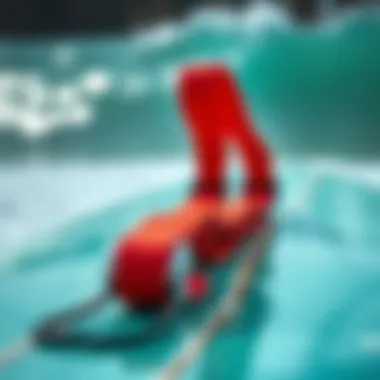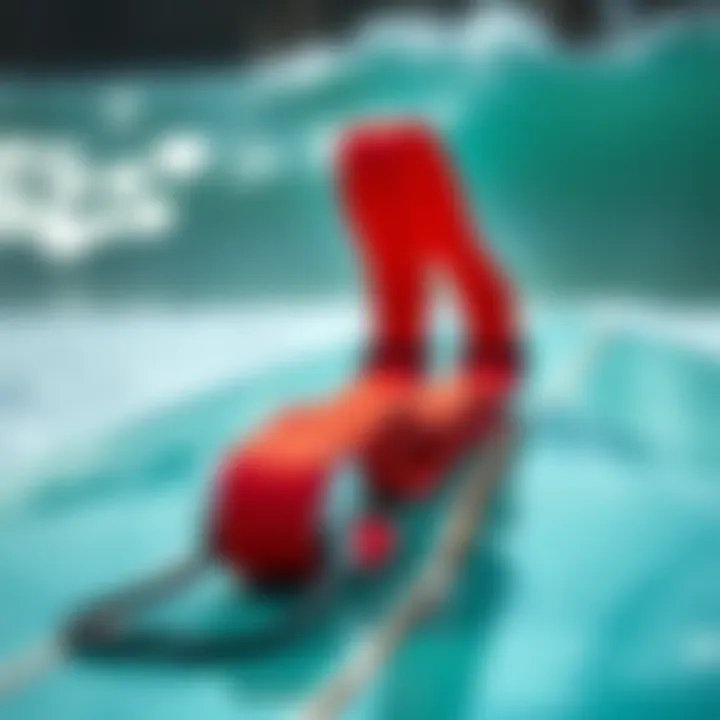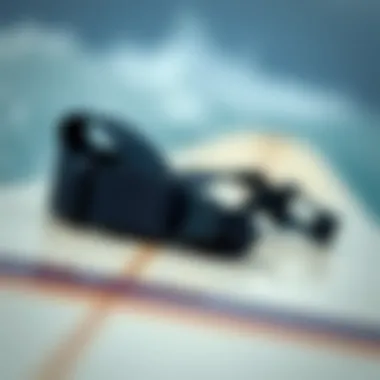Essential Insights on Surfboard Straps for Safety


Intro
Surfing is not just a sport; it’s a lifestyle rooted in the waves and the water’s spirit. For dedicated surfboarders, optimal performance on the water often boils down to the subtle details – one of which is the strap attached to their surfboards. Straps, commonly an overlooked aspect of surf gear, play a pivotal role in both safety and performance during those exhilarating rides.
The choice of strap can greatly affect how a surfer feels on the board, how efficiently they can maneuver, and the overall experience associated with catching that perfect wave. In this guide, we’ll take an extensive look into the world of surfboard straps. We’ll explore the different types, materials, proper fitting techniques, and maintenance tips. The nuances of strap usage extend beyond just performance; they also impact transportation and storage of the board. Moreover, we'll touch upon technological advancements, ensuring surfers are well-equipped to choose the best straps matching their individual needs.
Whether you’re a seasoned professional or just starting out, understanding the intricacies behind surfboard straps will enhance your connection with the surfboard and the waves that you ride. Join us as we delve deeper into this essential component of surf gear.
Surfing Techniques
Advanced Maneuvers for Experienced Surfers
When it comes to pushing the limits on your surfboard, having the right strap can make all the difference. Advanced surfers often engage in intricate maneuvers like aerials, cutbacks, and tube riding. These techniques require not only skill but also reliable gear that can withstand intense movements.
- Strap Thickness: A thicker strap provides stability while performing high-impact tricks.
- Flexibility: A strap that is too rigid can hinder your movement. Opt for materials that balance firmness with flexibility.
- Grip Quality: Look for straps with textured surfaces; this enhances grip during execution of Taylor's moves.
Using straps designed for performance can help in executing these advanced techniques more reliably, ensuring safety and enhancing control.
Beginner Tips for Catching Your First Wave
If you’re new to the surfing scene, choosing the right strap can seem like a daunting task, but it doesn’t have to be. Beginners should prioritize comfort and security over advanced features as they learn to catch their first waves.
- Choose Lightweight Straps: A lightweight strap will not weigh down your board, allowing for easier paddling and maneuvering.
- Focus on Fitting: Ensuring the strap is fitted properly is key. A loose strap can cause your board to slip away during pivotal moments.
- Material: Beginners often benefit from softer synthetic materials that can provide comfort while learning balance.
Gear and Equipment Reviews
In-Depth Review of the Latest Surfboards
It’s crucial to note that the compatibility of straps with surfboards goes hand in hand with the board’s design. Top brands continuously innovate their products, merging strap technology with surfboard efficiency.
Many surfboards today are equipped with strap attachments that allow various strap types to be utilized. Make sure to check compatibility with brands such as:
- Channel Islands Surfboards
- Firewire Surfboards
Essential Accessories Every Surfer Should Have
Beyond straps, a few accessories can complement your surfing experience, enhancing both safety and enjoyment:
- Leashes: Essential for preventing loss of your board in the surf.
- Wax: A good wax job ensures sufficient grip, working in tandem with your strap.
- Board Bag: For transport and protection, a board bag will prolong the lifespan of your surf gear.
Straps may be an overlooked aspect of surfing gear, but they certainly hold their weight in critical moments on the waves. Str identification is a vital step to establishing one’s surfing routine, promoting safety and enhancing overall performance. As we continue to explore the qualitative advancements in strap designs, you will be better equipped to make choices aligned with your surfing ambitions.
For further insights on surf gear and safety, check out articles from Wikipedia or Britannica. Engage with communities on Reddit to gain perspective on experiences and recommendations from fellow surfers.
Foreword to Surfboard Straps
Surfboard straps, though often overlooked, play a vital role in the surfing experience. They might seem like simple accessories, but their significance stretches far beyond just keeping the surfboard attached to a surfer's body or ensuring ease of transport. In this guide, we will dissect various aspects of surfboard straps and their benefits, helping surfers, marketers, and travel planners alike gain a deeper understanding of their importance.
Straps serve multiple key purposes: safety, performance enhancement, and convenience during transport. For surfers, having a reliable leash strap can prevent unnecessary accidents. Picture this: you wipe out, and your board goes flying away. The wrist strap keeps your board tethered, reducing the chances of it becoming a dangerous projectile or drifting away into the abyss.
On the performance side, a well-fitted ankle strap allows the surfer more freedom to maneuver. This is because the strap creates a sense of security, knowing that the board won’t float away when catching that perfect wave. When surfers are relaxed, they concentrate better on their technique and can push their limits, improving their skills.
Transporting surfboards can be a hassle, especially if you're traveling to a beach that's a fair distance away. The right board straps facilitate secure transportation, preventing damage during a bumpy car ride or while loading and unloading from a beach parking lot.
As surfing continues to grow in popularity, understanding the nuances of straps becomes crucial. The materials used, the fit, and the style of straps can greatly affect the overall surfing experience. It’s not just about aesthetic; it's about functionality.
"Choosing the right strap is as important as selecting the right surfboard. It can make or break your time in the water."
Moreover, this guide will explore diverse types of straps—from leash straps to board straps—and their due importance. Each type of strap is designed for distinct purposes, and knowing what works best for your surfing style and environment can significantly enhance your outing.
Purpose and Importance of Surfboard Straps
Surfboard straps play a crucial role in the surfing experience, influencing not just how surfers ride the waves but also how they manage their gear during transport and storage. Anyone who has ever had to deal with a loose board while surfing knows how vital it is to have a secure, reliable strap. This section explores the multifaceted purpose of surfboard straps, covering safety considerations, performance enhancement, and the convenience that these straps bring when transporting surfboards.
Safety Considerations
When venturing out into unpredictable waters, safety must always be top of mind. Straps serve as a lifeline, quite literally, ensuring that the surfboard remains connected to the surfer, even in the roughest of conditions. A well-fitted leash strap helps prevent injuries caused by boards flying back towards surfers or other beachgoers after a wipeout. According to the National Park Service, loose surfboards can pose significant risks in crowded beach areas. Having a durable strap fastened securely greatly reduces these hazards.
- Proper Attachment: It's essential to ensure that your strap is correctly attached to both the board and your ankle. An incorrectly fastened strap can give the false sense of security, leading to accidents.
- Material Strength: Choosing straps made from high-quality materials also contributes directly to safety. A fraying strap might just snap at the worst moment, turning a fun day in the water into a dangerous situation.
In summary, robust straps not only enhance one's surfing experience but safeguard against potential risks on the water.
Performance Enhancement
Believe it or not, the right strap can potentially improve surfing performance. By keeping the board securely attached to the surfer, straps allow for more freedom of movement without the worry of losing the board. This can be particularly useful when executing tricks or riding waves, as a stable connection allows surfers to concentrate on balancing and maneuvering, rather than worrying about their board floating away.
- Stability: A secure strap aids in the transition from paddling to standing, ensuring the board stays in the expected position.
- Efficiency: Efficient paddling is crucial in surfing. Straps that are too loose can cause instability, while a snug fit allows for energy-efficient movements, leading to better wave rides.
Ultimately, the optimal use of surfboard straps results in improved performance and a more enjoyable surfing journey.
Convenience in Transport
Transporting surfboards can sometimes feel like herding cats—awkward and tricky. Here, the usefulness of straps shines brightly. Straps facilitate the bundling of multiple boards, making it easier for surfers to carry their gear from the car to the beach. A well-designed strap system dramatically simplifies the process, allowing surfers to keep their hands free for essentials like sunscreen or a cold drink.
- Ease of Handling: Straps enable surfers to tie multiple boards together for convenient transport. This not only saves space but reduces the risk of damaging the boards while lugging them around.
- Compatibility with Vehicles: Specialized strap systems are available that cater to various vehicle types, from hatchbacks to roof racks, ensuring boards stay put even during a rugged journey.


In essence, the right surfboard strap doesn’t just secure the board; it streamlines the entire surfing experience, from the moment surfers leave their homes until they hit the water.
Types of Straps for Surfboards
Understanding the different types of straps available for surfboards is essential, as each type serves a unique purpose and contributes to the overall surfing experience. Whether you’re a seasoned pro or just starting out, choosing the right strap can enhance your safety, comfort, and performance. The effectiveness of surfboard straps lies in how well they connect the surfer to their board, ensuring stability while riding waves or during transit.
Leash Straps
Leash straps are vital components for every surfer. They prevent your board from drifting away after a wipeout, allowing you to catch up without chasing it down the beach. Made from durable materials like urethane, leashes come in various lengths and thicknesses to accommodate different surfing styles and conditions. When selecting a leash strap, consider both the size of your board and the type of waves you typically ride. A thicker leash may provide more security, while a thinner one maximizes performance by reducing drag.
"A good leash is not just an accessory; it’s essential gear for staying connected to your board when the water gets wild."
Ankle Straps
Ankle straps are specifically designed to attach the leash securely to the surfer's ankle. This is an important feature that adds to the comfort and functionality of the leash. Ankle straps often come with padding for added comfort during longer sessions. Proper fitting is key—an overly tight strap can hinder movement, while a loose one can lead to unwanted releases. When choosing an ankle strap, ensure the closure mechanism is reliable to avoid accidents during use. Color choices are often varied, allowing surfers a chance to express their personal style.
Board Straps
Board straps play a different role in the ecosystem of surf accessories, as they aren’t directly related to safety in the water but are indispensable for transport. These straps help secure your board to a rack or within a carrier. Made from heavy-duty materials, board straps are typically adjustable, providing flexibility for different sized boards. When selecting a board strap, consider the width and strength of the strap to ensure it can hold your equipment securely while on the road or in transit.
In summary, each type of strap serves a unique purpose and enhances the overall surfboarding experience from riding the waves to transporting your gear. Keeping the specifics in mind allows surfers to make informed decisions that best fit their needs.
Materials Used in Surfboard Straps
Selecting the right materials for surfboard straps is not just a matter of preference; it plays a crucial role in performance, durability, and overall experience on the water. The right materials can enhance not only safety but also comfort and usability during those critical moments when every second counts. Let’s delve into the common materials used in surfboard straps, focusing on their properties and how they can impact your surfing journey.
Nylon and Polyester
When it comes to surfboard straps, nylon and polyester are the two heavyweights in the ring. These synthetic materials are known for their excellent durability and resistance to stretching, which is vital when securing your board.
- Strength: Both nylon and polyester boast high tensile strength, meaning they can withstand significant force without breaking. This makes them ideal for the rough treatment that surfing gear often encounters.
- Weather Resistance: They are highly resistant to wear from sunlight and saltwater exposure. This resistance helps maintain the integrity of the straps over time, making them a solid investment for surfers who frequent various conditions.
- Lightweight: Despite their strength, these materials are surprisingly lightweight. This feature is especially appreciated by surfers who need to carry their boards and gear over long distances.
In short, choosing straps made from nylon or polyester provides you with the peace of mind that your board will stay secured whether you’re catching a wave or hauling it across the beach.
Neoprene Padding
Neoprene padding is another popular choice, especially when it comes to comfort. This material is often integrated into the straps to enhance the user experience.
- Cushioning Effect: Neoprene offers a softer touch against the skin, which is beneficial during long surfing sessions. It reduces friction, helping to prevent chafing or discomfort.
- Water Resistance: Naturally, neoprene is also waterproof. This property helps repel water, preventing the straps from absorbing moisture, which could lead to deterioration over time.
- Thermal Insulation: For those surfing in cooler waters, neoprene provides a bit of insulation, giving a slight warmth that can be comforting when submerged in chilly waves.
For many surfers, the added comfort of neoprene makes a noticeable difference, especially for those who are out on the water for extended periods.
Eco-friendly Alternatives
As environmental consciousness rises among enthusiasts, eco-friendly strap options are surfacing in the market. These alternatives often use sustainable materials or practices, making them an appealing choice for the eco-minded surfer.
- Recycled Materials: Some modern straps utilize recycled plastics and other materials, which not only helps reduce waste but also appeals to those looking to lessen their carbon footprint.
- Natural Fibers: Straps made from organic cotton or sustainably sourced hemp offer a non-toxic, biodegradable alternative. These materials are typically less durable than synthetic options but can provide a unique aesthetic and feel.
- Biodegradable Plastics: Innovations are emerging in the form of biodegradable synthetic materials that decompose over time, offering a balance between performance and environmental responsibility.
Opting for eco-friendly straps aligns with a commitment to sustainability without compromising on performance. Though durability might vary compared to traditional materials, the contributions to environmental health are significant.
"Using eco-friendly materials not only benefits surfers but also helps protect the oceans we love to ride on." - Surfer Magazine
Selecting the Right Straps for Your Needs
Choosing the right straps for your surfboard is more than just a matter of personal preference; it’s a critical component that can greatly affect your surfing experience. Strap selection plays a vital role in ensuring safety, comfort, and performance on the waves. If you’ve ever tried to surf with ill-fitting straps, you’ll know how cumbersome and distracting they can be. On the other hand, when the fit is just right, you'll often find that it enhances your overall experience.
When selecting straps, consider several specific elements such as material, width, and design. Finding the right straps doesn't just impact your connection to the board; it can improve your maneuverability and stability as well.
Assessing Fit and Comfort
Getting the right fit is crucial for any surfer. Straps that are either too tight or too loose can lead to uncomfortable rides or, worse, accidents. It’s important to try various straps and see how they feel while standing on your board. When strapping in, you should feel secure without cutting off circulation to your ankles or feet.
"Always remember, comfort can significantly improve your performance. A good fit lets you focus on riding those waves instead of adjusting your gear."
To assess comfort properly:
- Check the padding: Cushioned straps made from neoprene or soft fabric can help prevent chafing.
- Ensure adjustability: Many straps come with adjustable features that can cater to different foot sizes. Practice making these adjustments before hitting the waves.
- Test flexibility: Strap designs that allow some flexibility can lead to a more natural feel while surfing. Don’t overlook the importance of mobility.
Choosing Based on Surfing Style
Your surfing style greatly influences the type of straps you need. For instance, if you are an aggressive surfer who loves big waves and tricks, you might need straps that offer a higher level of support and control. Alternatively, if you are more into casual paddling and longboard riding, you might prefer simpler, lightweight options.
Here are some considerations based on surfing style:
- Performance-Oriented Surfers: Look for straps with extra padding and secure clips. Brands like Dakine and Rip Curl offer excellent products designed for performance and durability.
- Casual Riders: If you enjoy a relaxed surfing style, you might focus more on comfort rather than ultra-tight grips. Soft, adjustable straps made from materials like cotton or foam could be your go-to.
- Freestyle Adaptability: Freestyle surfers often need straps that provide a balance between grip and comfort. Look for options that allow for easy adjustments to suit various tricks without sacrificing security.
Attaching and Adjusting Straps Properly
The process of attaching and adjusting straps correctly is crucial when it comes to getting the most out of your surfing experience. Properly secured straps can mean the difference between a fun day out on the waves and a disastrous one filled with lost boards or accidents. The significance of this task does not merely lie in the straightforward mechanics of attaching straps; it extends to user confidence, safety, and performance. Straps that are poorly attached or incorrectly adjusted can lead to discomfort, distraction, or worse, serious injuries.
Step-by-Step Guide
- Gather Your Materials: Make sure you have all necessary components ready—this includes the straps, surfboard, and a stable surface to work with.
- Check the Straps: Inspect your straps for any signs of wear, fraying, or damage. Ensuring they're in good shape beforehand can prevent problems later.
- Align the Straps: Start by placing the straps in the appropriate spot on your surfboard. Typically, this would involve aligning the strap with the fins and any existing attachment points on the board.
- Secure the First Strap: Fold the strap over a key attachment point or insert it through a loop on the board. Pull it tight, but not so tight that it compromises the strap’s integrity.
- Adjust for Comfort: After securing the first strap, check that it feels comfortable. There should be enough slack to allow for movement without feeling loose.
- Repeat with Remaining Straps: Use the same method for any additional straps. Make sure they’re all at similar tension levels to maintain balance.
- Final Adjustment: Once all straps are attached, give each one a tug to ensure they are properly secured. If needed, adjust them to get that ideal snug fit.
Following this guide not only ensures comfort but also enhances your overall performance on the water.
Common Mistakes to Avoid


While it may seem straightforward, attaching and adjusting straps often comes with its own share of pitfalls. Avoid these common mistakes:
- Neglecting Condition: Don't skimp on checking the condition of the straps. Worn-out straps can break, leading to accidents.
- Disregarding Fit: Over-tightening straps can cause discomfort while surfing, potentially distracting you from the waves.
- Ignoring Manufacturer Instructions: Every strap may come with specific instructions. Ignoring these could lead to improper attachment.
- Skipping a Second Check: Always double-check your work before hitting the waves. A few minutes spent double-checking can save a lot of trouble later.
"The devil is in the details"—taking the time to ensure your straps are properly adjusted cannot be overstated.
By understanding the importance of attaching and adjusting straps properly, surfers can significantly enhance not only their safety but also the enjoyment of their time spent riding the waves. Make it a habit to treat this aspect of surfing with the attention it deserves.
Maintenance and Care of Surfboard Straps
Taking care of your surfboard straps goes beyond just keeping them looking nice. Proper maintenance enhances their longevity, ensuring that they function effectively when needed. Quality straps are not just a convenience; they can be the difference between a great surfing experience and an unfortunate accident. Over time, wear and tear can degrade the materials, making regular attention to maintenance crucial. Ignoring this aspect can lead to costly replacements or, worse yet, safety hazards while out on the water.
Cleaning Techniques
Cleaning your surfboard straps should be a part of your regular routine. Saltwater and sand can do quite the number on materials, leading to faster degradation. Here’s how to keep your straps in top shape:
- Rinse After Use: Always give your straps a good rinse with fresh water right after your session. This removes salt and sand that can cause corrosion and abrasions.
- Use Mild Detergent: If they’re particularly dirty, you can use a mix of warm water and mild detergent. Scrub gently with a soft brush to avoid damaging the fabric.
- Avoid Harsh Chemicals: Stay away from bleach or strong solvents that can weaken the material.
- Air Dry: Let the straps air dry in a shaded area. Avoid direct sunlight for long periods, as UV rays can deteriorate the materials.
Storage Recommendations
Storing your surfboard straps properly can be just as important as cleaning them. Improper storage can lead to tangles, kinks, or even mold growth. Here are some tips on how to store them:
- Keep Them Untangled: Use a dedicated storage bag or strap to keep the straps untangled. This simple practice helps maintain the shape and functionality.
- Cool, Dry Place: Store your straps in a cool, dry location to prevent moisture-related damage. Humidity can foster mold growth on straps made from certain materials.
- Avoid Heavy Loads: When not in use, avoid placing other heavy items on top of the straps. Excess weight can stretch or warp them over time.
"Investing a little time in cleaning and proper storage can save time and money in the long haul. Don’t let neglect take the fun out of your surfing experience!"
In summary, maintaining and caring for your surfboard straps involves regular cleaning and thoughtful storage practices. By following these guidelines, you’ll ensure that your straps remain functional and extend their life, so you can focus on what really matters – catching those waves.
Innovations in Strap Technology
In the ever-evolving world of surfing, strap technology has not been left behind in the wave of innovation. These advancements not only enhance the functionality of straps integral to the surfing experience but also address the growing demands of safety and performance. Innovations in this area are crucial for surfers looking to make informed choices about equipment.
The significance of strap technology cannot be overstated. As surfing styles and conditions change over time, so too do the requirements of surfers. Here, we take a closer look at two notable innovations that have emerged in recent years: smart straps and enhancements in durability.
Smart Straps
Smart straps may just sound like a buzzword, but they encompass a range of features designed to improve functionality. These straps can come equipped with sensors that can track various data metrics, such as wave height, speed, and rider posture, which can then be transmitted via Bluetooth to a mobile device. This connectivity lays the groundwork for real-time feedback, enabling surfers to adjust their techniques while out on the water. Moreover, some models incorporate GPS functionalities, providing valuable navigation assistance to surfers venturing into unfamiliar waters.
- Benefits of Smart Straps
- Track performance metrics, enabling improvement over time.
- Ensure the safety of surfers with GPS tracking in case of emergencies.
- Facilitate data-sharing within the surfing community for collective learning.
The interplay between smart technology and traditional sporting gear marks a noteworthy shift in how surfers interact with their environment. However, not every surfer may need or desire this additional complexity. For those who prefer a more tactile experience without the digital fuss, the next wave of strap technology focuses on durability.
Durability Enhancements
When it comes to strap technology, one of the most pressing concerns is durability. Modern advancements address this by incorporating high-strength materials and innovative design features. Straps are now made from materials that withstand the test of time and resist damage from saltwater, UV rays, and wear-and-tear from daily use.
- Key features of durable straps include:
- Reinforced stitching that prevents fraying and breaking under tension.
- UV-resistant treatments to reduce degradation from sun exposure.
- Water-resistant coatings that prevent mold or mildew from forming.
By focusing on these attributes, manufacturers aim to extend the lifespan of straps while ensuring they perform reliably in all conditions. The balance of functionality and resilience is essential to keeping surfers safe and allowing them to focus on what truly matters: riding the perfect wave.
As technology continues to advance, so does our ability to tailor equipment to specific needs, enhancing both performance and safety for surfers at all levels.
The future of strap technology is bright, with additional innovations likely on the horizon. Surfers should keep an eye out for updates in this area, as the right strap can significantly enhance their experience on the water.
Comparative Analysis of Popular Strap Brands
When it comes to surfing, the right straps can make all the difference—whether you’re paddling out or riding the waves. Straps play a significant role in ensuring not just safety but also performance. In this section, we will explore why conducting a comparative analysis of popular strap brands is paramount for surfers looking to make informed purchasing decisions.
Importance of Brand Analysis
Understanding the variations among different strap brands allows surfers to identify which products offer reliability, durability, and specific features that enhance their surfing experience. Here are some key considerations when analyzing strap brands:
- Quality of Materials: Different brands use varying materials, affecting comfort and longevity.
- Pricing: It’s important to find straps that fit within your budget without compromising essential features.
- User Feedback: Looking at what other surfers say can provide practical insights.
- Innovative Features: Some brands may offer unique adjustments or ergonomic designs to enhance performance.
"Choosing a surfing strap isn’t just a matter of brand loyalty; it’s about finding the right fit for your style and needs."
Brand A Overview
Brand A has solidified its presence in the surfing community with a steadfast commitment to quality and innovation. Their products boast the following:
- Material: Made from high-grade nylon, Brand A's straps are both lightweight and exceptionally strong. They are known for resisting wear and tear, which is critical for surfers.
- Design Features: Many come equipped with adjustable lengths, ensuring they can easily fit on various surfboards. This flexibility is particularly useful for surfers who switch between boards often.
- User Reviews: Users praise the comfort and reliability of these straps, with many noting that they provide great support when out on the water.
Despite their higher price point, many consider Brand A a worthy investment due to its durability and performance.
Brand B Overview
Brand B is another player that has carved out a niche in the surfboard strap market. Known for its affordability, it nevertheless stands out in several ways:
- Material: Utilizing a combination of polyester and neoprene, Brand B’s straps offer decent stretch and cushioned support, making them friendly on the ankle.
- Unique Selling Proposition: The brand often highlights its eco-friendly materials, appealing to environmentally-conscious surfers.
- User Feedback: While some users admire the comfort, others have raised concerns about its lifespan. Many suggest that while the initial performance is good, durability might not match that of higher-end brands.
In summary, for surfers on a budget, Brand B can provide satisfactory performance, but it’s essential to manage expectations regarding longevity.


In the ever-evolving world of surfing accessories, comparing strap brands not only informs purchasing decisions but also enhances the overall experience on the waves. Proper straps are a core component of a surfer's gear, fundamentally influencing comfort and safety.
The Role of Straps in Surfboard Transportation
When it comes to transporting surfboards, the importance of straps cannot be stressed enough. Straps serve as the backbone of secure travel, ensuring that the board remains in place throughout the journey. Without the right straps, a surfboard can easily become damaged, not to mention pose a risk to the vehicle and other road users.
Effective straps not only protect your prized possession but also prevent potential accidents that can arise from loose equipment. Choosing high-quality straps is thus paramount for those who frequently hit the road with their boards. Understanding the nuances of strap usage for transportation will empower surfers to be more mindful about their gear and safety.
"Straps are like the unsung heroes of surfboard travel; they carry the weight of security on every road trip."
Securing Boards for Travel
When loading a surfboard onto a vehicle, it's essential to ensure that it is secured properly. This begins with selecting the right type of straps. Many surfers prefer using cam buckle straps for their strong holding capacity and adjustability. These straps come with an easily operated mechanism that allows for quick tightening without hassle.
A few critical steps in securing your board include:
- Positioning the Board: Lay the board on its side, with the tail pointing backwards. This minimizes wind resistance when driving.
- Using Padding: Consider adding padding between the strap and the board to avoid dents and scratches.
- Tightening Techniques: Draw the strap to snugness, but not so tightly that it compromises the board's structure. Too much pressure could warp the board or loosen the fins.
- Double-Check: Before moving off, a last-minute check ensures that everything is in order. You wouldn't want to hit the road only to discover your board has shifted.
Strap Systems for Different Vehicles
Different vehicles require different setups for strap systems, and being aware of these differences can save you time and trouble. For instance, if you're using a compact car, you may find that using standard roof racks comes in handy. Conversely, larger vehicles like vans or trucks might benefit from specialized mounts that offer more flexibility.
Some common setups include:
- Roof Racks: These provide an anchor point for your straps, and many have designated slots for surfboards. Look for designs that prevent slipping.
- Trunk Straps: Ideal for smaller vehicles, these straps wrap around the back of the trunk, allowing you to secure the board directly to the vehicle's frame.
- Tailgate Pads: Perfect for trucks, these pads allow you to secure multiple boards while providing padding to protect against scratches.
Every strap system should prioritize not just security but also ease of use. The ability to set up quickly is essential, especially when you're excited to hit the waves. Remember that your selection of straps should reflect both the type of vehicle you are using and the amount of traveling you'll be doing.
In summary, understanding the role of straps in surfboard transportation can not only enhance your safety but also provide peace of mind. Investing time in the right systems and techniques ensures your boards arrive at their destination, ready to catch the perfect wave.
Identifying When to Replace Straps
Knowing when it's time to swap out your surfboard straps is crucial for both safety and convenience. Old or damaged straps can lead to avoidable accidents out in the water, along with frustration during transport. Keeping a keen eye on the condition of your straps ensures they perform effectively, providing the support you need without fail.
Signs of Wear and Tear
When you’re out catching waves, the last thing you want is a strap malfunction. To help you dodge that scenario, it's essential to be vigilant for certain signs of wear and tear:
- Fading Color: If your straps have started to lose their vibrant color, that’s a red flag. UV rays, saltwater, and sand exposure degrade materials over time. Faded straps not only look worn but they often lose integrity too.
- Fraying Edges: Check for any fraying or loose threads on the edges of the straps. This can indicate that they are about to break. It might not seem like a big deal at first, but a frayed strap can snap under pressure, especially during a wipeout.
- Cracks or Brittle Spots: If you see cracks or feel a crunchiness when bending your strap, it’s a clear sign that it has aged significantly. This brittleness usually comes from exposure to harsh elements.
- Lack of Flexibility: Straps should bend smoothly and return to their natural shape after you stretch them; if they don’t, they’re likely sacrificing performance and might be on their last legs.
These signs might not all appear at once, but keeping a checklist can guide your decision on replacement. Don't take unnecessary risks.
Longevity of Different Materials
When considering the lifespan of surfboard straps, the materials they are made from play a pivotal role. Here’s a breakdown of some common materials and their longevity:
- Nylon: Generally, nylon straps are durable and can last a long time if properly maintained. However, exposure to saltwater and UV rays can accelerate deterioration. Expect to replace nylon straps every couple of seasons.
- Polyester: Similar to nylon, polyester straps are strong but have better resistance to UV light. When treated well, they can last a few years but be sure to monitor them regularly for signs of wear.
- Neoprene Padding: Straps with neoprene padding provide comfort but have a shorter lifespan than the other two materials due to dampness and exposure to saltwater. These often need replacing every year, particularly if used frequently.
- Eco-friendly Alternatives: Materials such as reclaimed plastics or organic cotton are great for those looking to make sustainable choices. These tend to have a shorter lifespan, generally requiring replacement every year or so, depending on conditions and usage.
Understanding the longevity of materials can not only save you money in the long run but also ensure that your safety isn't compromised. Like the old saying goes, "A stitch in time saves nine," so don’t let your straps go into decline.
Community Insights on Strap Preferences
Understanding the preferences of the surfing community regarding straps is vital for refining product choices and identifying trends that influence purchasing decisions. These insights come not only from personal experiences shared by surfers but also from collective discussions that shape brand innovations and improvements. Being aware of community favorites can enhance one’s surfing experience significantly, helping surfers avoid common pitfalls and opt for gear that truly meets their needs.
Trending Opinions from Surfers
When it comes to surfboard straps, opinions vary widely across regions and styles, reflecting the unique conditions and cultures inherent in different surfing communities. Surfing enthusiasts often gather on forums and social media platforms, voicing their thoughts and preferences. For example, many favor straps that are lightweight yet durable, providing freedom of movement while ensuring that they do not snap under pressure.
A recent survey on a popular surfing forum indicated that around 65% of respondents expressed a preference for neoprene-padded ankle straps. This preference seems to stem from the comfort and added cushioning that these straps offer. Surfers often mention how important comfort is during long sessions on the water, and neoprene seems to strike a good balance between sturdiness and wearability.
Moreover, some surfers delve into the aesthetics of their gear. They appreciate straps that come in various eye-catching colors or patterns. As one surfer pointed out:
"When I’m out on the waves, I want my gear to reflect my style. That confidence translates into my performance."
This perspective reinforces the idea that strap selection is not solely functional. It's an extension of a surfer's identity, illustrating a deeper connection to one’s chosen sport.
Feedback on New Innovations
The surf community is always abuzz with excitement when new innovations hit the market, especially when they claim to enhance performance or safety. Straps equipped with smart technology, for instance, have piqued the interest of many. Some straps now come with integrated sensors that monitor performance metrics, such as wave count and removal timing, adding an intriguing layer to the surfing experience. Early adopters have reported positive feedback regarding how these functionalities can enrich one’s understanding of their surfing habits.
However, durability remains a concern. While the tech features are appealing, many surfers worry about potential malfunctions in challenging conditions. As one seasoned surfer remarked on Reddit:
"It’s great to have tech, but if it fails while I’m catching the perfect wave, that’s a deal-breaker. My safety comes first."
This highlights the ongoing tension between innovation and reliability, a balance that strap manufacturers must strike to cater to the evolving needs of surfers.
The community's insights provide valuable perspectives that help both surfboard manufacturers and their wearers navigate the diverse market of straps. They illuminate the need for practicality, comfort, and style, helping shape quality products that transition from the workshop to the waves seamlessly.
The End and Final Thoughts
In wrapping up our thorough examination of surfboard straps, it’s crucial to glean insights about why these pieces of equipment mean more than just an accessory. Straps uphold the safety, performance, and convenience of surfing. Without them, you risk losing control of your board, which can lead to dangerous situations in the water or during transport.
First off, the connection between a strap's effectiveness and your overall surfing experience cannot be overstated. Well-designed straps enhance performance by ensuring a secure fit, allowing surfers to focus on mastering the waves rather than worrying about their gear. This element is particularly important for those pushing their limits on high-risk maneuvers. Choosing the right strap isn't just about preference—it's about creating a safety net for yourself and your gear.
Also, when it comes to transporting your surfboard, the right straps play a pivotal role in protecting your investment. Straps can bridge the gap between rough trips and smooth rides when heading to your favorite surfing spot. An essential part of this is understanding the various strap systems suited for different vehicles, from cars to bikes. Properly securing your gear means less worry and more time catching waves.
As technology progresses, innovations in strap materials and designs continue to revolutionize the surfboard accessory market, offering surfers more choices than ever before. New eco-friendly alternatives, and smart features mean that sustainability and convenience can go hand in hand, keeping surfers aligned with both performance and environmental consciousness.
In the end, whether you're a seasoned surfer or just starting, investing time in understanding the types, materials, and maintenance of surfboard straps can significantly enhance your experience. Remember, as with any gear you depend on, taking the time to evaluate, care for, and replace straps will pay dividends when you're out in the water. Stay safe, perform better, and enjoy your ride!
"The right gear can transform an average day into an extraordinary experience—don’t underestimate the power of good straps."
For further insights and community-driven tips, resources such as reddit.com/r/surfing or your local surf shop can provide valuable advice tailored to your specific surfing needs.















